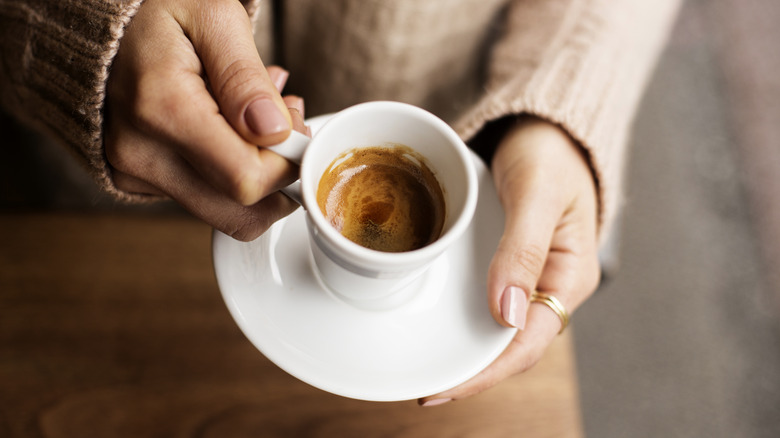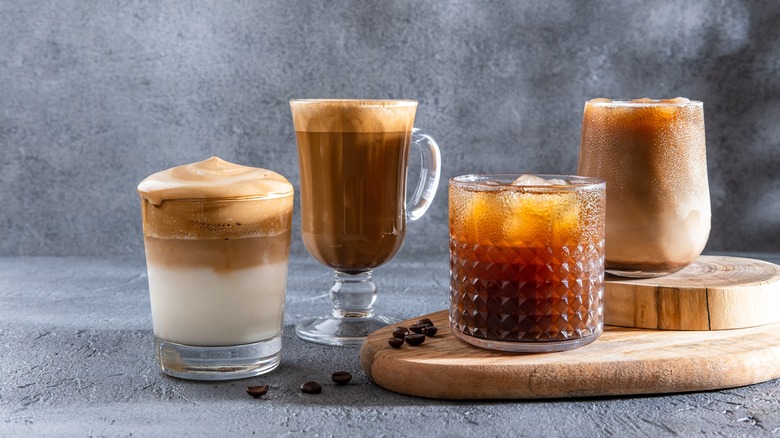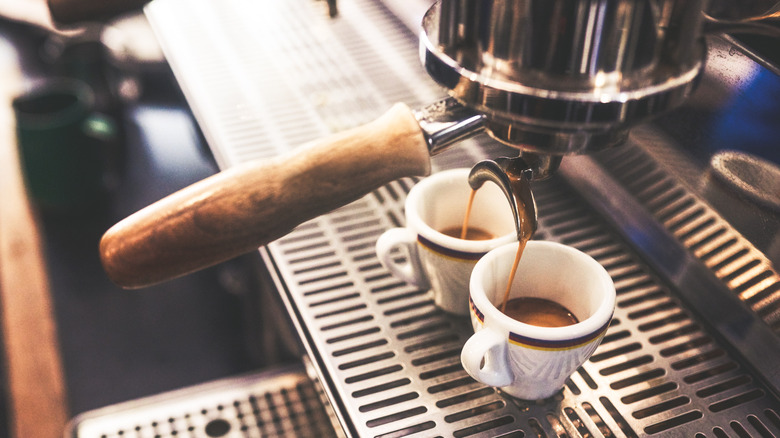What Does It Mean To Order Espresso 'Ristretto' Or 'Long-Shot'?
Coffee is hot, delicious, and sometimes intimidating. When going to your local coffee shop, it seems that there are almost infinite options to choose from. And you would think that when it comes to espresso, it is one-size-fits-all. However, that simply isn't the case. There are several ways in which you can order your espresso to customize your coffee experience. And two espresso drinks that are gaining popularity are "ristretto" and "long-shot" espresso.
But what does it mean for espresso to be ristretto or long-shot? There are two different methods to brew espresso that vary from the standard espresso shot. Ristretto-brewed espresso is unique because it's a more concentrated version of espresso, in which the beans are more finely ground. Ristretto espresso also uses a higher bean-to-water ratio, giving a fuller body and a more concentrated taste. On the other hand, a long shot — otherwise known as a lungo — uses more water than a typical espresso shot. And though this may seem like a small difference, it can completely alter the taste and texture of your espresso shot. Knowing the specific features of both can help you to choose the best espresso for your caffeine needs.
The coffee-to-water ratio
But the difference between a long shot and a ristretto espresso shot comes down to more than just size. Though ristretto is typically a smaller pour than the standard espresso shot, and a long shot is larger than the typical espresso shot, you will want to consider more than just size when choosing between them.
For one, ristretto is more concentrated than a long shot and has a higher coffee-to-water ratio when brewing. Ristretto typically has a bean-to-water ratio of about 1-to-1 or 1-to-1.5, meaning that ristretto is about equal parts coffee and water. This gives the ristretto a stronger, more concentrated taste. Ristretto is also thicker than your typical espresso shot and can make a great alternative to espressos when making homemade drinks such as café lattes or flat whites, giving your drink a strong and slightly sweet twist. That being said, a shot of ristretto-brewed espresso can also — and should also — be enjoyed on its own.
Meanwhile, a long shot has more water than an espresso shot. A standard shot of espresso has a coffee-to-water ratio of 1-2, while a long shot has a coffee-to-water ratio of 1-to-3. Therefore, a long shot usually has a milder taste and features less crema, which is a creamy, foamy topping typical of a well-brewed espresso shot. In contrast, ristretto features a thicker crema and a stronger (but also sweeter) taste that brings out the best qualities of your espresso.
A shot for different moods
Beyond their differences in taste and texture, there are also other key differences between the two espresso variations. For one, ristretto has a higher caffeine content than regular espresso and long shots and can be a great alternative to double espresso for those wanting a heavy dose of caffeine. But ristretto offers more than just convenience and a punch of energy. It is also a drink to be enjoyed and fully tasted. Its concentrated flavor and thick crema make it a wonderful treat to fully indulge in.
Meanwhile, the exact caffeine content of a long shot is debated. Some believe that it has more caffeine than espresso. However, due to it having the same amount of espresso grounds as coffee, long shots most likely have a similar caffeine content to espresso. But long shots also provide more volume, so don't think of them as less concentrated versions of espresso. A long shot is a unique drink all on its own, with a flavor profile that is more complex than your typical espresso shot. A long shot can feature a smoky flavor and thinner texture, making it great for sipping. It also has a thinner crema than espresso and ristretto. So if crema isn't your thing, you might want to give a long shot a try.
Of course, there is no one-size-fits-all espresso choice. You might want to try each brew type on its own and learn to appreciate each espresso type for its unique properties.


